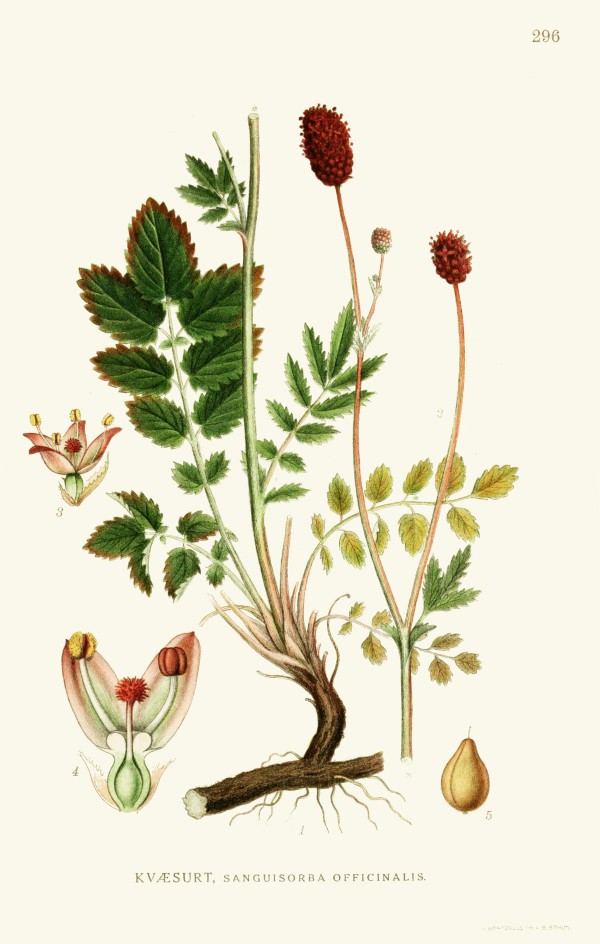Sanguisorba officinalis L. - syn.Sanguisorba polygama F. Nyl.; Poterium officinale (L.) A. Gray; - Rosaceae
burnet, great burnet, burnet bloodwort, Großer Wiesenknopf
Perennial herb, up to 1.20m high, native to Eurasia, naturalized in North America, commonly cultivated; rootstock brown or purple-brown; leaves forming a rosette, odd-pinnate; leaflets ovate, serrate, above dark green, below pale green; flowers small, dark red to brown.
Sanguisorba officinalis var. longifolia = 长蕊地榆 chang rui di yu (chin.)
Sanguisorba officinalis var. officinalis = Sanguisorba carnea Fisch. ex Link = 地榆 di yu (chin.)
http://www.efloras.org/florataxon.aspx?flora_id=2&taxon_id=200011628
„The roots of burnet are known to be effective against acute diarrhoea. The herb also has antihaemorrhage properties and has been used to treat ulcerative colitis, metrorrhagia (uterine bleeding) and topically against haemorrhoids, various skin conditions (wounds, ulcers, burns and eczema) and mucosal inflammations (included in gargles and tooth pastes). The main traditional use (in Europe and China) is to stop bleeding, as is reflected in the generic name sanguis (blood) and sorbeo (I absorb)… The tannin and saponin contents are clearly in agreement with the observed astringent, antimicrobial, anti-inflammatory, haemostyptic and antidiarrhoeic effects.“
[Medicinal Plants of the World. Ben-Erik Van Wyk and Michael Wink, Pretoria 2004, 287]
„The yields of crude eq-extracts, polysaccharide, flavones, tannins and saponins by extraction, isolation and partial purification form Sanguisorba Officinalis in this experiment… were 1.45 %,1.27 %,0.87 % and 0.88 %. The results of the enzyme kinetic assays showed that tannins and flavone had a better inhibition effect than Glucobay. And both of their inhibition was competitive; Ki of tannins and flavone were 0.030 9 mg/mL and 0.076 5 mg/mL; IC50 of them were 8.13×10-2mg/mL and 0.266 mg/mL. Flavone showed a higher thermal stability, but tannins hadn't the property. The experiment confirmed that Sanguisorba officinalis was a good source of α-glucosidase inhibitors and Sanguisorba officinaliss flavone and tannins may become promising candidates for blood sugar reducing functional factors.“
[A Screen of α-Glucosidase Inhibitors from Sanguisorba Officinalis., Chen, Li-hua, et al., Food Research and Development 9, 2013, 9]

Lindman, C.A.M., Bilder ur Nordens Flora, vol.2 t.296 (1922-1926)
http://www.plantillustrations.org/species.php?id_species=904777
Sanguisorba officinalis © Rolf Marschner (2006) http://botanische-spaziergaenge.at/viewtopic.php?f=411&t=1160
